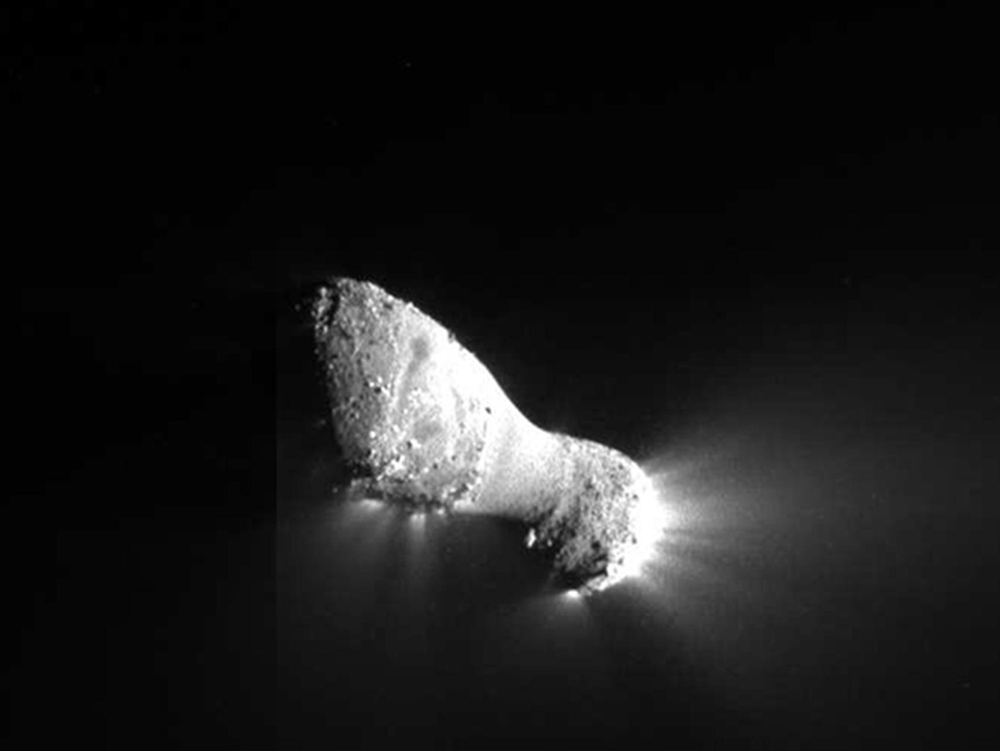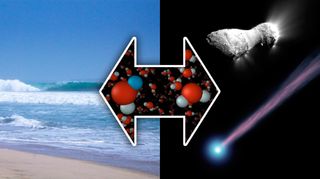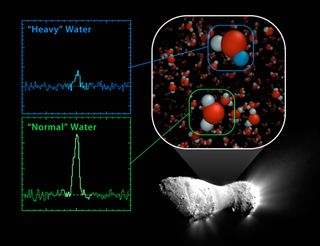Comets Created Earth's Oceans, Study Concludes

The dirty snowballs known as comets might be the sources of Earth's water after all, scientists say.
Water is critical to life on Earth — life is found virtually wherever there is water on our planet. Researchers have spent decades debating where Earth's water and other key ingredients of life came from.
Prior studies had suggested that early Earth was dry, lacking water and other so-called volatile materials.
Now Earth-like water has been discovered in the small oddball comet Hartley 2, which the Deep Impact/EPOXI spacecraft flew by in November2010. This comet originated in the disk-shaped Kuiper belt, a region of the solar system beyond the orbit of Neptune, suggesting this is ultimately where much of Earth's water came from. [Photos: Comet Hartley 2 Up Close]
"When the Earth formed it was so hot that most volatiles escaped to space, so when the Earth cooled down it was dry," said study lead author Paul Hartogh, a planetary scientist at the Max Planck Institute for Solar System Research in Katlenburg-Lindau, Germany. "Water and other volatiles must have been delivered at a later stage."

Earth water from comets?
Comets are natural candidates for the original sources of the world's seas, loaded with ice as they often are. However, computer models of how the solar system formed have suggested that asteroids actually were the source of most of the planet's oceans, with comets delivering no more than 10 percent of Earth's water.
Get the Space.com Newsletter
Breaking space news, the latest updates on rocket launches, skywatching events and more!
To identify the original sources of Earth's oceans, scientists compared isotopes of the hydrogen found in the planet's water to isotopes of hydrogen seen in extraterrestrial bodies such as comets. All isotopes of an element have the same number of protons, but each has a different number of neutrons — for instance, regular hydrogen has no neutrons, while the hydrogen isotope known as deuterium has one neutron.
Scientists used the European Space Agency's Herschel Space Observatory to observe the ratio of deuterium to regular hydrogen in comet Hartley 2. In Earth water, approximately 1,558 deuterium atoms are seen per 10 million regular hydrogen atoms.
Comets, icy water-bearers
Past measurements of six comets from the giant spherical Oort cloud beyond the Kuiper belt saw approximately 2,960 deuterium atoms there per 10 million regular hydrogen atoms, which had suggested they were not the source of Earth's water.
Prior studies of meteorites known as carbonaceous chondrites originating from asteroids had water more like that seen on Earth, with about 1,400 deuterium atoms per 10 million regular hydrogen atoms.

Now researchers find that water seen in Comet Hartley 2 is very close to Earth's, with about 1,610 deuterium atoms per 10 million regular hydrogen atoms.
"With our finding it may be that more than 10 percent and perhaps all water on Earth possibly stems from comets," Hartogh told SPACE.com.
It may be that all bodies in the inner solar system get their water from these comets. Sampling a larger number of comets for their deuterium-hydrogen ratios could shed light on the matter, Hartogh said.
The scientists detailed their findings online Oct. 5 in the journal Nature.
Follow SPACE.com contributor Charles Q. Choi on Twitter @cqchoi. Visit SPACE.com for the latest in space science and exploration news on Twitter @Spacedotcom and on Facebook.
Join our Space Forums to keep talking space on the latest missions, night sky and more! And if you have a news tip, correction or comment, let us know at: community@space.com.

Charles Q. Choi is a contributing writer for Space.com and Live Science. He covers all things human origins and astronomy as well as physics, animals and general science topics. Charles has a Master of Arts degree from the University of Missouri-Columbia, School of Journalism and a Bachelor of Arts degree from the University of South Florida. Charles has visited every continent on Earth, drinking rancid yak butter tea in Lhasa, snorkeling with sea lions in the Galapagos and even climbing an iceberg in Antarctica. Visit him at http://www.sciwriter.us